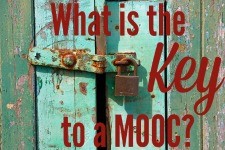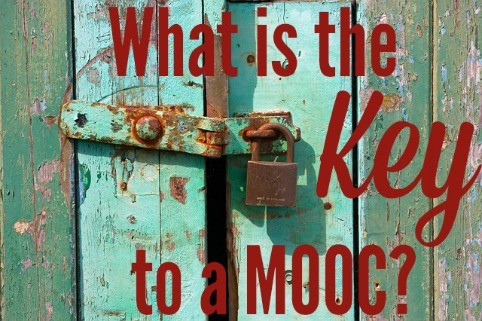My affinity for the promise of the Massive Open Online Course, or MOOC, is well documented. However, while enrolled with thousands of colleagues I did identify the experience as disconnected from my daily practice. I sometimes wanted to brainstorm with local peers how ideas in the course translated to my classroom. After completing three MOOCs last spring I knew there was impactful content available to my peers; but it appeared hidden behind a door that only persistence could unlock. Persistence? I’ve developed that, could I help others through a MOOC or two?

IDENTIFY THE RIGHT OPPORTUNITY
If I was going to lead educators I knew through a MOOC it had to be the right one. I liked all three I completed last year, but one struck me as a potential “bridge MOOC.” This MOOC had elements recognizable from every education course ever taken; I assume other educators would identify the same elements and take comfort in that familiarity. This MOOC could bridge what they understood about the teacher profession to the new format of a MOOC.
This MOOC also dedicated the first half of the course to building background knowledge and providing professional readings which would serve the teachers of our district beyond this single experience. Part of identifying the right opportunity had to account for potential dropouts. This MOOC consisted of a reading and discussing phase, followed by a production and submission phase. I identified weeks 1-4 as a time frame I could support district participants in this new format, but weeks 4-8 where each participant would have to decide if they wanted to progress on their own. This course would provide background knowledge even if the participant dropped out once the start of the hard requirements began. This made it easier to approach my supervisor with a plan to make this happen.
MASSIVE ONLINE? MEET WEEKLY FACE-TO-FACE
I identified the lack of local accountability with the ease of dropping out from any MOOC. If participants had support through the initial phase of learning the MOOC organization, course expectations, and the procedures of “doing” the course I speculated I could help them remain in the course. I had a proposal to submit to my supervisor. I asked to shift my one work day one hour later for the duration of the face-to-face support and advertised physical meet-ups in advance of the start of course with the Media Specialists of each school in my district, on my work group’s blog, and with physical fliers to each school in my district. This was in addition to the district messaging to building Principals.
I offered these face-to-face support meetings through the first half of the course only for two reasons. First, I identified this as the period participants are most likely to drop out. Second, I thought the material during the first half of the course was more universally applicable to what teachers would need to transition to a blended delivery model within our district. While this MOOC offered a relatively large number of re-certification credits for those finishing I judged that self-motivation would carry many participants through the end of this course and that if I continued to meet with them they would only be seeking approval from me instead of submitting their authentic work and gaining real feedback from course participants like themselves. I judged I only needed to provide support for the first half of this MOOC for them to meet my definition of success.
“…drop-out/non-completion rates are substantially higher than in more traditional education”
Clow, Doug. MOOCs and the funnel of participation. Proceedings of the Third International Conference on Learning Analytics and Knowledge. ACM, 2013.
GATHER BACKGROUND KNOWLEDGE
I knew this was a good course, but I had to verify that it was not just the excitement of completing my first MOOC. During and after I first took the course, I utilized twitter to connect with one of the MOOC instructors specifically.
During ISTE, the instructor presented about MOOCs and in particular how this MOOC performed. I made sure to attend and learn. I wanted to learn how such a huge free course can translate to monetary gain for a college. I made sure to connect with the instructors present and encourage them to run the MOOC again.
Based on the presentation and our conversations, they expected to run the MOOC again in January of 2015. I knew that was my opportunity to lead a group of local educators through that MOOC.
FOSTER INDEPENDENCE “PLUS”
The MOOC offered a Facilitator’s Guide, but my unknown was how to encourage participation and not turn independent thought into a group activity. My greatest asset was that I had already completed this MOOC and could share my experience. I was able to give an overview and then offer to be a resource. I introduced the schedule for face-to-face meetings and my availability during any work day. I explained how I was and was not able to assist them during our first meeting. I can offer technical or navigation guidance, the course provide strategies for gathering feedback on assignments. I made sure to call out how I planned to model the academic honesty that this MOOC requests. At our last face-to-face meeting I shared a prior submission via a projector for the style, format, and length. I made clear that we would not be sharing a copy of this, but how they could make their own and post it the course for collegial feedback.
CELEBRATE: EFFORT AND PERSISTENCE
Many of your peers have not participated in a MOOC, but they are in education, they can do this. Help them to identify elements which are the same as prior face-to-face experience. This reminds them of their capabilities and allows them to focus on their assignments and not be caught up in “online” and “massive” aspects of the course. A few of our district members received “shout outs” in the weekly wrap-ups. I made sure to share the good news with authority figures and send the participant a nice message. Any time you can provide the personalized accolades that a massive course cannot duplicate you are further investing them in course participation.
One … hurdle that prevents MOOCs from reaching their transformative potential is that they fail to provide the kind of social environment that is conducive to sustained engagement and learning…
D. Yang, T. Sinha, D. Adamson, and C. P. Rose. Turn on, tune in, drop out: Anticipating student dropouts in massive open online courses. In Workshop on Data Driven Education, Advances in Neural Information Processing Systems 2013, 2013.
Some say MOOCs are dead, but the death of MOOCs is an oversimplification. Let’s allow the idea of being a lonely students out of thousands of students to die; let’s participate in these MOOCs as pre-formed groups. Let’s approach this challenge in our strongest form, together! If the key to a MOOC is persistence, don’t you have a duty to share your persistence with your colleagues?






1 Pingback